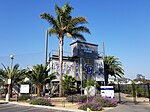Isla Vista, California

Isla Vista (Spanish for "Island View", prounounce EYE-luh VIS-tuh locally) is an unincorporated community and census-designated place (CDP) in Santa Barbara County, California, in the United States. As of 2020 census, the community had a population of 15,500. The majority of residents are college students at the University of California, Santa Barbara, or Santa Barbara City College. The beachside community of Isla Vista lies on a flat plateau about 30 feet (9 m) in elevation, separated from the beach by a bluff. Isla Vista enjoys a Mediterranean climate and often has slightly less precipitation than either Santa Barbara or Goleta. Isla Vista is located on a south-facing portion of the Santa Barbara County coast, between Coal Oil Point and Campus Point in view of the Channel Islands. During El Niño years, precipitation in Isla Vista can be excessive and potentially dangerous. Some homes and apartments built on the south side of Del Playa Drive, most popular with students due to their direct ocean views, are in danger of collapse, since they are built on quickly-eroding bluffs thirty to sixty feet above the Pacific Ocean. Recent erosion has exposed foundation supports in several of the properties closest to the university campus, UCSB. As Isla Vista is on the south coast of Santa Barbara County, which has some of the highest housing prices in the United States, the student population shares densely packed housing with a working class Hispanic population. Since Isla Vista has not been annexed by either Goleta or Santa Barbara, remaining unincorporated, only county funds are available for civic projects. While the main campus is to the east, the community is surrounded on three sides by university property governed by the state Board of Regents.Isla Vista is home to a student housing cooperative, the Santa Barbara Student Housing Coop, as well as a food cooperative, the Isla Vista Food Co-op.
Excerpt from the Wikipedia article Isla Vista, California (License: CC BY-SA 3.0, Authors, Images).Isla Vista, California
Abrego Road,
Geographical coordinates (GPS) Address Nearby Places Show on map
Geographical coordinates (GPS)
| Latitude | Longitude |
|---|---|
| N 34.413333333333 ° | E -119.86083333333 ° |
Address
Abrego Road 6647
93117
California, United States
Open on Google Maps






